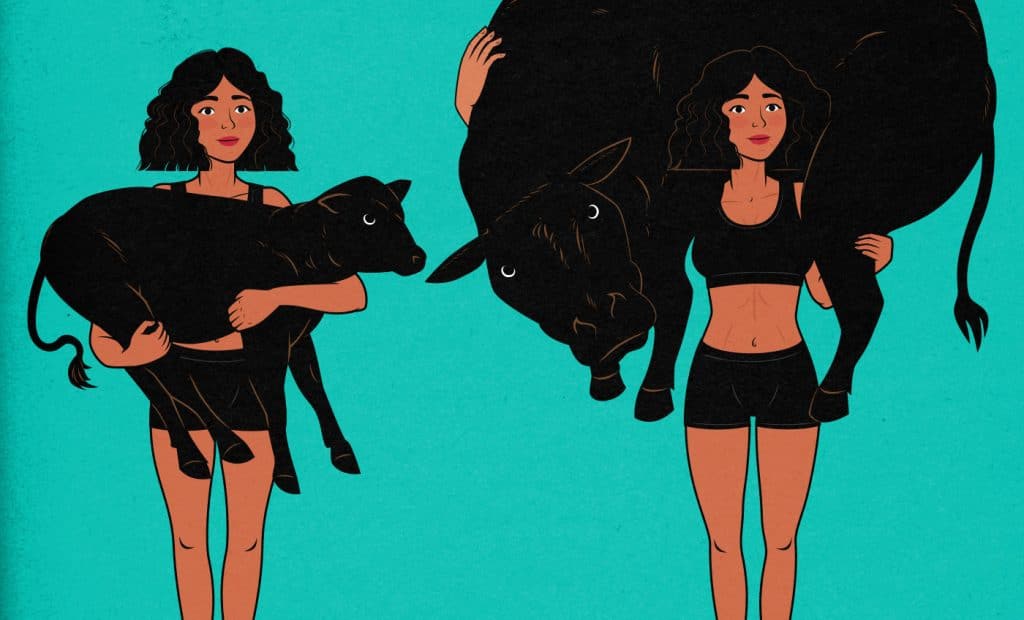
Signs Of Gaining Muscle For Females
When you’re trying to gain muscle, it’s normal for a woman to wonder if what you’re doing in your workouts is actually working. It takes time, patience, and consistency to see muscle gain. So you won’t see results overnight. But on the other hand, continuing to do something that isn’t working, especially over many weeks, is a surefire way to waste time and kill your motivation. So what are some signs to tell if your muscle gain efforts are actually paying off or not?
Signs Of Gaining Muscle
The Science Of Muscle Growth Can Give Us Clues
An increase in muscle size (hypertrophy) happens when there is enough tension on the muscle fibres that their structural integrity is being compromised. The body reacts to this stress by adapting and undergoing changes so that it can handle more stress in the future without the same damage.
What this means is that you will continually need to be outlifting your muscles, day after day, week after week, if you want to see continued muscle growth adaptation.
If you stop challenging your muscles to make them adapt, they’ll fail to grow, and they’ll stay the same.
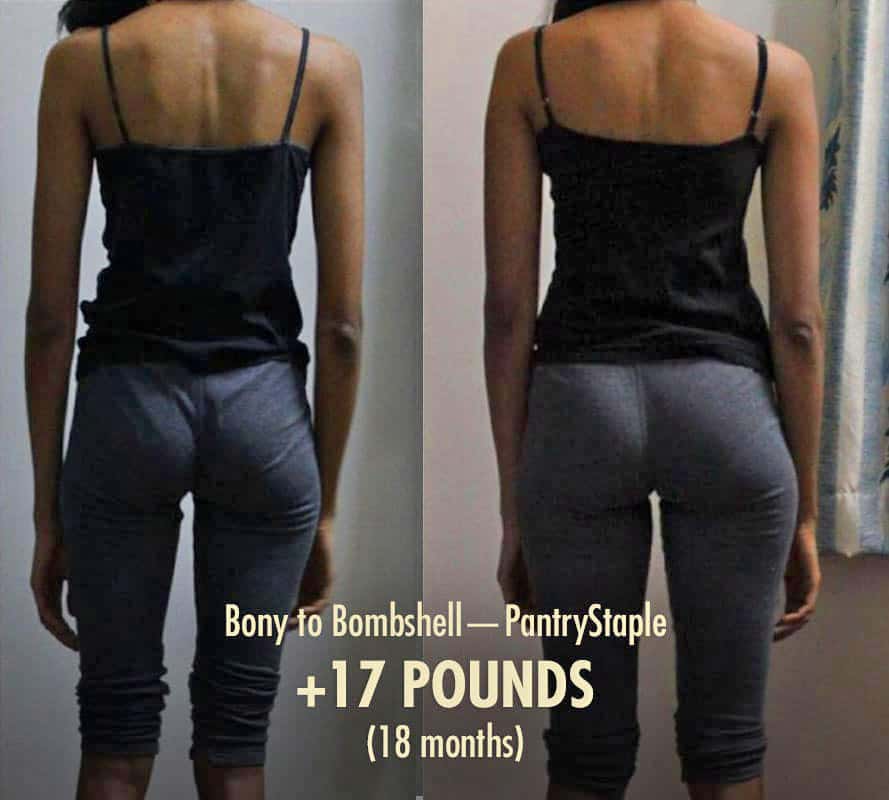
1. Getting a good burn/pump in your workouts.
Metabolic stress is believed to be a part of muscle growth, but it’s a bit of a vague term. The general idea, though, is that the muscles require sugars (glucose) and ATP to make the muscles contract. As the ATP breaks down, there is a collection of hydrogen ions in the area, which increases acidity in the area, causing the burning feeling.
This metabolic stress causes a high demand for sugars at one time, telling the body it will need to adapt. It might help by causing cell swelling, hormonal release, or the production of reactive oxygen species (ROS), but it’s not definitive science yet.
In fact, the burn is not even guaranteed to help with muscle growth. But it can be used as a good sign to pay attention to. The other helpful thing is that a burn can help you discover if the exercise is hitting the right muscles for you. For example, depending on your form, a high-rep push-up could make your triceps burn more (elbows tucked), or your pecs burn more (elbows flared.) It can help teach you more about form and muscle activation.
2. Muscle Soreness (DOMS)
Muscle soreness, otherwise known as delayed onset muscle soreness (DOMS), is muscle damage. This is where there are microtears in the muscle, causing the body to see it as inflammation and to send white blood cells to go clean up the area. After the area is cleaned up, the muscle is repaired to be stronger.
These micro tears often happen most when the muscle is stretched, and this is one reason why a full range of motion is best for muscle growth. Focus more on the stretch portion of a lift versus the contracted portion of the lift.
However, this muscle damage can be overdone. In untrained people not used to lifting weights, sometimes it can take two weeks to heal from too much muscle damage. If you cause too much damage and then lift again before it’s healed, you could put yourself at risk of overtraining and injuries.
Experiencing DOMS used to mean that it was a good workout sufficient for muscle gains. But all it guarantees is that you damaged your muscles. It is possible to overtrain your muscles, so much so that you have so much damage that you spend all your time recovering and not even rebuilding! So you want the workouts to be challenging enough to stimulate adaptations but not so challenging that you can’t sit down in a chair without groaning for the following week. Plus, aside from your workouts, you will still need sufficient recovery to rebuild your muscles.
By the way, DOMS goes away if you stay consistent with lifting. But if you’re currently suffering from it, buying a foam roller for daily use at home can help. Here’s a video of Marco detailing how to foam roll which can help with the soreness:
3. Getting Stronger
Getting stronger at your lifts is one of the easiest ways to tell if you’re gaining muscle. If you start off glute bridging 110 pounds, and now you’re glute bridging 300 pounds like Aomi did, then you can put good money on it that you’ve gained muscle.
In research, they’ve found that powerlifters with the most muscle were the winners in lifting the most weight (2015). Research has also shown that you can accurately predict who will be the strongest in these combinations by measuring their muscle size (2022).
Now that doesn’t mean that it’s perfect. It is possible to get stronger without gaining muscle. My business partner Shane had worked himself up to a 225-pound bench press while still having tiny 11″ arms. He was putting himself through gruelling workouts. His body was getting stronger. His bones got denser. His nervous system got better at firing those specific muscle fibres. He got better at the bench press movement through skill improvements, etc. But he wasn’t eating enough calories and enough protein for muscle growth, and he eventually plateaued in strength.
But strength is one of the closest markers we can trust in, especially if you’ve been doing the same lift for a few weeks now and you’re getting good at it.

So if you’ve stopped getting stronger, that’s a sign that your muscle gains have slowed or even stopped. If you’re continually able to pick up more weight, that’s a solid sign that you’re gaining muscle.
- Can you lift a heavier weight? If you are dumbbell Romanian deadlifting 60 pounds, and the next week you can do the same reps/sets, but with 65 pounds, you’re getting stronger.
- Can you do more reps? On a week-to-week basis, you won’t always be able to add more weight. But maybe instead of 8 reps, you can do 10 reps with the same effort. That’s a sign you’re getting stronger.
- Can you do more sets? Sometimes when you can’t add more weight and you’re fighting to keep your reps, you can just add another set to keep progressively overloading your muscles. So if you’re doing 2 sets of an exercise and not seeing as much growth, you can try doing 3 sets and trying again.
GET THE GOOGLE SPREADSHEET OF THE
FREE female BEGINNER’S FULL-BODY WORKOUT
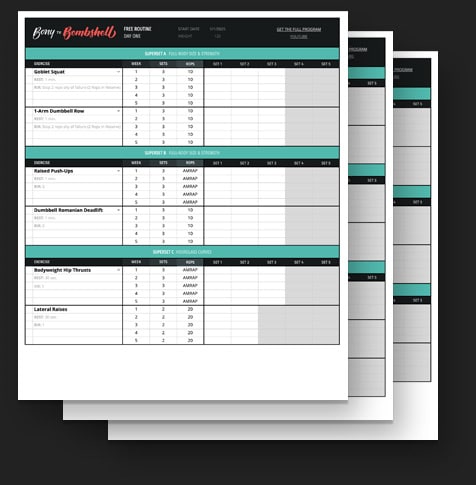
Get the workout as a Google spreadsheet. You’ll be able to pick from exercise alternatives, fill out the sheet, and get our beginner’s warm-up.
Plus, we’ll make sure you’re on the Bony to Bombshell newsletter, and send you all of our best women's muscle-building content.
4. Getting Heavier / Gaining Weight
Gaining weight, by definition, will always include some muscle gain. Even without lifting weights, a portion of weight gain from a calorie surplus will be muscle—but most of it will be fat. So if you just sat on the couch and ate more food, at least a little bit of it would be muscle.
But you can radically improve the muscle-to-fat ratio as you gain weight. You can do this by:
- Lifting weights.
- Still getting into a calorie surplus, but keeping the surplus smaller—around 250 calories per day. (Bigger surpluses allow faster total muscle gain but at the downside of a worse muscle-to-fat ratio.)
- Eating a higher protein muscle-gain diet.
Since you’ll be lifting weights already, you’ve already shifted things in your favour. If you’re getting heavier, you are most certainly gaining some muscle. If you’re having trouble getting into a consistent calorie surplus, smoothies can help.
GET THE sample PDF recipes OF THE
weight-Gain Muscle-building Smoothies
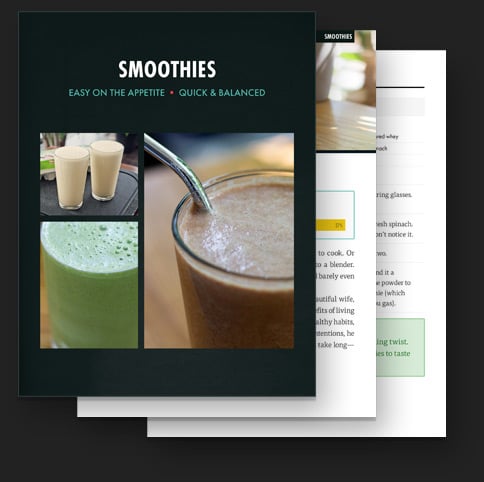
Get some sample smoothies recipes in a downloadable PDF file. Get the full explanation, ingredient list, macros, and steps to follow.
Plus, we’ll make sure you’re on the Bony to Bombshell newsletter, and send you all of our best women's muscle-building content.
5. Your Measurements Are Changing In The Right Ways
We recommend that all of our Bony To Bombshell members take body part measurements using a tailor’s tape before they get started. If your hip circumference, which measures your glutes, is increasing in size, there’s a good sign that you are gaining muscle size in your glutes.
Now, there is some fat on your body part measurements too. But many women will, unfortunately, gain the most fat on the belly. So ideally, you will want to see your waist measurement hold steady or even drop a bit while seeing measurement increases in other areas.
For example:
- Waist +1″, hips +0.5″. In this example, this is a poor muscle-to-fat ratio and shows fat gain. They likely did not gain much muscle because the waist was growing faster than the hips, signalling too much fat gain.
- Waist 0″ change, hips +1″. This is a good sign that there is muscle gain in the hips. Fat levels are holding steady at the waist, while there are measurable changes in areas measuring muscle gain.
- Waist –1″, hips+1″. This is the golden ticket, simultaneous fat loss while seeing muscle gain. This happens most to women who are skinny-fat or overweight while combining a lifting workout with a good high-protein but calorie-deficit muscle-building diet. (For naturally, skinny women, they are already lean and will need to eat more calories to see predictable muscle gain.)
6. Mirror Changes
We’ve heard stories from many beginners saying that they hadn’t seen any weight or measurement changes, but began noticing see muscles in the mirror. Maybe their butt looks a bit perkier, and the muscle has shifted up. There could be a 1″ of fat loss while gaining 1″ of muscle mass, totally a zero-inch change. But it looks radically different, and it is!
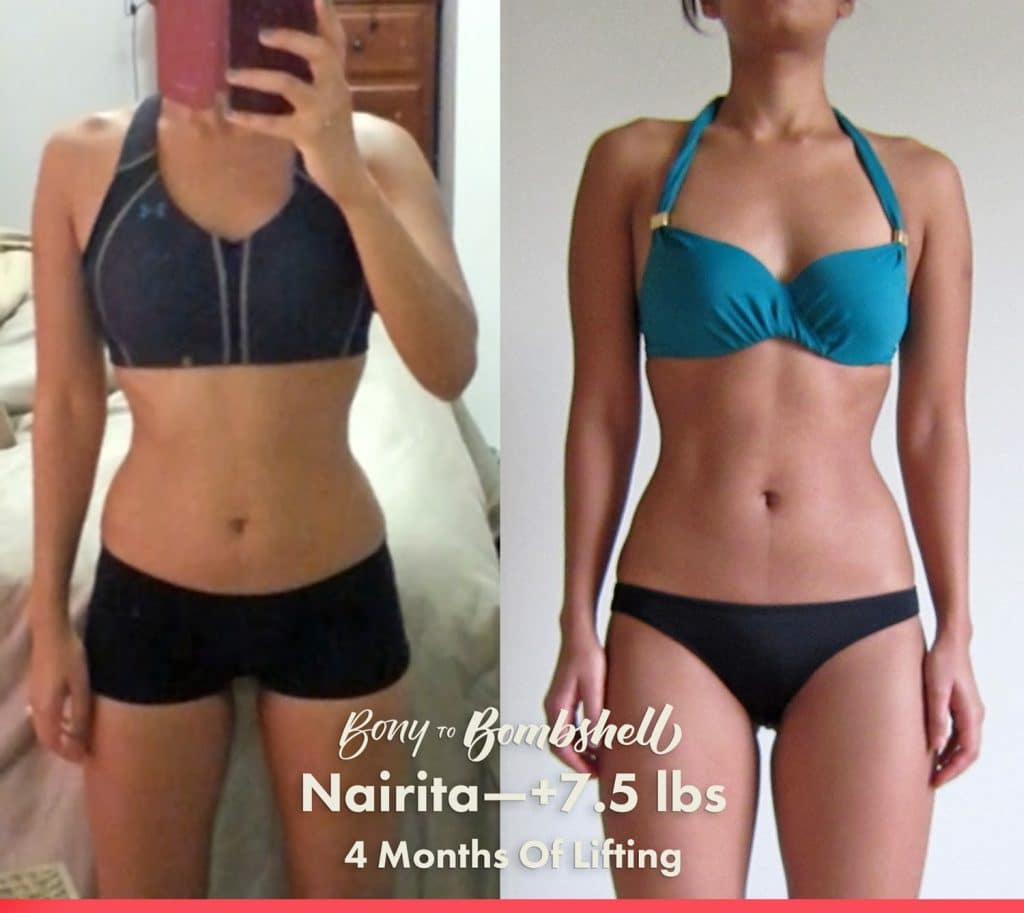
We had one member send in photos of her new shoulder muscles that were popping just after a couple of workouts. So if the measurements aren’t changing, but you’re seeing changes in the mirror, and you’re feeling stronger, and you’re feeling lean, there’s a good chance there’s some real muscle gain going on.
7. Photo Changes
Mr Olympia winner Frank Zane was adamant about taking photos and not relying on the mirror. He found that the mirror couldn’t always be trusted and that we would manipulate the angles to get the result we wanted when looking at it. He advised getting someone else to take a photo to get a real-life angle and more objective documentation. We recommend our members take a photo update at the end of each workout phase, which is once every five weeks.
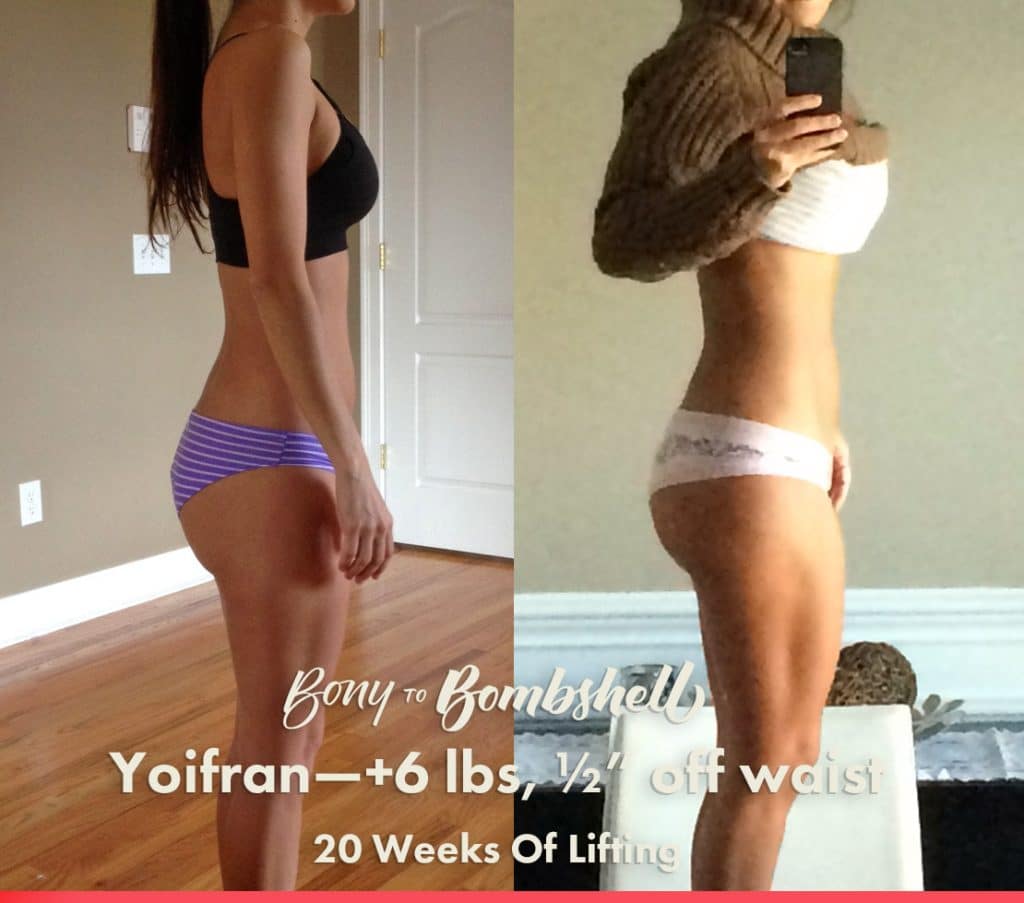
Other Factors With Signs Of Muscle Gain
Heads Up: Muscle Growth Adaptations From Lifting Is Local—Not Systemic
There used to be old beliefs that the body only works as a unit, and so to grow your arms, you’d also need to do squats to generate enough hormonal response needed for growth. There’s been a few studies on this idea, and it doesn’t seem true (1985).
Now, this might not be shocking to you, but what this means is that the exercises you do will grow those muscles. Exercise selection matters a lot for where your muscles will grow.
So, if you want your glutes to grow, you need to do glute-stimulating exercises. Program in some full-body compound movements that hit the glutes, like goblet squats and Romanian deadlifts, but also give your glutes some extra isolation work like glute bridges or hip thrusts.
Or put another way: don’t expect your glutes to grow from your shoulder presses.
This also means that if you don’t want any muscle groups to get bigger, don’t train them. Some women don’t want bigger shoulders or bigger arms, so they don’t need to train them at all if they don’t want to. Other women want their arms sculpted a bit, and once they find a size, they can stop lifting heavier and heavier. If you’re not gaining muscle size in the area you want, you need to change something.
- Move the exercises that hit the muscle group earlier in a workout.
- Program in more sets (weekly volume)
- Play with the rep ranges. If you’re doing low-rep work (like 5-rep sets), try some moderate rep work like 12-reps. Or vice versa.
Other Factors Affecting Muscle Gain
- Age, genetics, and starting health. Each one of us is an individual that will have their own unique history and experience with gaining muscle. In general, the older we get, the harder it is to build muscle. So if you’re older, you may need to temper your expectations and realize that you’ll need to be a bit more patient with the signs of muscle gain. Some of us are younger but were born to older mothers (or the youngest of many siblings) and are starting off further back on the race track. So muscle gain might be more difficult for some than for others. The important part is to realize that you can do it. Just keep at it, keep tweaking, and keep paying attention to your results.
- A well-designed lifting routine. Some lifting routines are too advanced and will annihilate your muscles into oblivion, ruining any chances of a good recovery. Some routines are too basic and too light, and your muscles won’t need to grow. Our Bombshell members get great glute gains because their glutes get strong. You will need a routine that is designed for muscle hypertrophy (size), a routine designed for women for exercise selection and smart volume design, and a routine that matches your skill level. Barbell back squats can be a solid lift depending on your goals, but not ideal for a beginner, when a dumbbell goblet squat is much easier to get going with and better for muscle shape due to the range of motion.
- A good muscle-building diet. Some women are doing solid programs, putting in the effort, and have been lifting for months but with little to show for it. If you want to see some muscle gain, your muscles need more “outside” material to build bigger with. Your body can’t build muscle out of thin air. That means more dietary protein and more energy to build with.
- Protein quality & muscle compounds. While plant-based foods have protein in them, muscle goes beyond just protein. Not only are plant-based proteins harder to digest (see our article on plant-based proteins here), but they’re missing other compounds aside from protein. Inside our muscles, we find compounds such as creatine, carnosine, carnitine, usable iron, zinc, etc. When you eat animal muscle, also known as meat, it has all of these extra compounds needed for muscle right in them—because it’s already formed muscle. If you are choosing to eat a plant-based diet, you may need to be more intentional about supplementation and/or experimentation to see muscle gain.
- Good recovery and lifestyle. If you do a good solid workout, eat good solid meals, and then sleep for 5 hours—good luck with seeing some muscle gain! It’s one thing to get the stimulus to build muscle, then eat well, and then not actually allow your body to recover sufficiently. I’ve found that lifting weights increases my need for sleep by about an hour, but we’re all different. So if you’re getting by on 6 hours, you might need at least 7 hours to see good muscle gain. If you need 7 hours, you might need 8 to see results. Pay attention and adjust if necessary. A good healthy lifestyle goes beyond just getting enough sleep. You’ll need a reasonable amount of sunshine, walking (daily steps), fresh air, and healthy relationships to keep your stress low so your body has the resources it needs to grow.
- Consistency, time, and patience. Beginners are infamous for being inconsistent. Stick with a solid routine for a good month and then judge more critically about how things are going. Most women won’t see noticeable results after one or two workouts. On the flip side, don’t be too patient. If you aren’t seeing any changes 8 weeks in of consistent lifting, nothing will suddenly start happening on week 12 or week 16. Something needs to change.
Q&A About Signs Of Muscle Gain
Q: What is the first sign of muscle growth?
A: If you’re brand new to lifting, the first sign you’ll probably get is muscle soreness. Lifting weights will cause DOMS. If you keep up with it and stay consistent, you will find the soreness will likely go away after a week or two, after your body gets used to lifting weights.
The most reliable sign will be tracking your strength, bodyweight and taking monthly bodyweight measurements. Many of our beginner members are gaining several pounds in their first week, with exploding strength. By the end of the month, they’ve added an inch or two onto their hips. Day by day, they’re seeing changes in the mirror.
So when you’re seeing muscle gain, you might expect to see most of the signs:
- Getting sore (at the beginning)
- Getting stronger (adding more weight to their lifts)
- Seeing measurement increases (such as seeing the hip measurements bump up)
- Seeing new muscle definition in the mirror, etc.
Q: How long does it take to see noticeable muscle growth in females?
A: We have a whole article on how fast and much muscle women can expect to build. A lot of our members are able to see rapid muscle growth in just one month. Here’s Aomi after just five weeks when doing our program.

Every woman is different, though. Some women are working long hours, have dependents, and will need to take things more slowly. Someone who is 18 years old and childless may be able to handle more workouts, spend more time doing meal prep, and dedicate more time to sleeping in. The main thing is that we find something that fits our style and that we keep up with it. If you can’t do 3 workouts a week, two workouts a week is still over 100 workouts during the year, and that can be great for muscle gain.
Q: So muscle gain is linked to strength… what if you’re struggling to gain strength?
A: The good news is that getting stronger has nothing to do with genetic variation. Even if you have poor genetics for building muscle, you can almost certainly still get your squat over 225 pounds, your bench press over 135, and your conventional deadlift over 300. The trick is that you need to build a bunch of muscle in order to do it (which is your goal right now anyway, so that’s great).
The real reason that most women fail to become strong is because:
- They can’t find any actual muscle-building programs meant for women. Most of the fitness programs out there simply aren’t designed to help women gain size and strength. Even dedicated lifting programs for women tend to be more about toning and cardio than building a powerful body. Everyone has different goals, and that’s fine—these programs are popular for a reason—but if you actually want to get bigger and stronger through muscle gain as a woman, you have to lift with those goals in mind.
- They don’t use coaches. Right when we started beta testing the very first version of our muscle-building program for women, we realized that we needed to include online coaching with every membership. We know that our members are going to run into problems, they’re going to have unique circumstances, they’ll benefit from feedback on their lifting technique, and they’ll have unique goals. We need to be there to help them through all of that. That’s the only way that we can guarantee progress.
- Intermediate lifters fail to put in enough effort.
- Beginners lack consistency.
If you have big goals and you approach them with a passion, you’re going to be able to accomplish incredible things, blowing past the average female lifter in no time. But if you aren’t building muscle properly, you’re not going to gain enough muscle mass to get anywhere even close to these muscle growth or strength targets.
The other thing to keep in mind is that progress requires getting a few things right all at once. Lifting for muscle growth (not only strength), nutrition, sleep, etc. If people don’t approach bulking properly, it’s not that they’ll progress more slowly, it’s that they won’t progress at all—ever. Zero gains per week add up to zero gains per year.
In fact, it’s possible to spend decades lifting weights without ever gaining more than 5–10 pounds of muscle and without ever even matching the strength of someone who followed a good program for a single year. If you never do this properly, you might go your entire life without ever knowing what it’s like to have a strong, healthy, curvy body.
Most women aren’t failing to see muscle gain because of genetic limitations. They’re failing because they aren’t following good muscle-building programs, they aren’t seeking the advice of qualified strength and conditioning coaches, and they aren’t pushing themselves consistently.
Q: What about using a DEXA scan to track muscle gain?
A: The most cutting-edge tool we have for determining if you’re seeing muscle gain is a DEXA scan with a hydration test. A DEXA scan stands for “dual-energy X-ray absorptiometry,” and it is an X-ray machine. It is commonly used for bone density tests, but it can also measure and tell the differences between:
- Bone
- Lean Mass
- Fat (adiposity)
Now, what exactly is “lean mass”? Is that muscle? Yes, it includes muscle. But it also includes other things. Lean mass includes things like:
- Internal organs (your heart, your liver, etc.)
- Connective tissues (your cartilage, your tendons, etc.)
- Skin
- Muscles
- How hydrated your body is (including water and glycogen in the muscles)
Because hydration can affect your lean mass score, the DEXA isn’t perfect for measuring muscle gains. However, imperfect tool as it is, a DEXA is still accurate enough to be used as a tool to tell if you’re generally gaining muscle or not (2018).
But the DEXA scan isn’t without tradeoffs:
- It exposes your body to X-ray radiation (allegedly to a similar level as an airplane flight, but still).
- It’s expensive.
- It’s time-consuming and requires some prep.
For 99% of women, it’s overkill. Just pay attention to the signs we covered above to know if you’re gaining muscle (getting stronger, your measurements, how you look in the mirror, etc.)
What Next?
If you liked this article, you’d love our muscle-building newsletter. We’ll keep you up to date on all the latest muscle-building information for women. Or, if you want us to walk you through the process of gaining muscle and strength, including teaching you the exercises, giving you a structured 5-month workout program, a complete diet guide, a recipe book, and online coaching/customization, check out our Bony to Bombshell Program.


FREE women's Muscle Growth MINI-COURSE
Get our 5-part female bulking mini-course that covers everything you need to know about:
Here are some related articles